Effective Ways To Prepare For Food Shortages
The world faces several serious challenges that could lead to food shortages in the coming months and years. Climate change, economic instability, global conflicts, and population growth all pressure the global food supply. This means we could see more famines and food price spikes in the future.
I heard several years ago that over 20 facilities in the US that process and package various food products we buy every day have burned down. That’s scary, and we must be aware of and prepare for possible food shortages now. That doesn’t count the farming communities under siege from foreign competition, supply chain disruptions, drought, or floods. We live in precarious times!
One quick trip to various grocery stores reminds us that food prices are still high, some products are in limited supply, and our favorite staples may not be offered for sale anymore. If you feel that you’re not as well prepared as you’d like to be, don’t wait, start planning and working that plan now. Food insecurity is a real concern for many families, no matter where you live, so you’re not alone. Let’s discuss effective ways to prepare for food shortages.
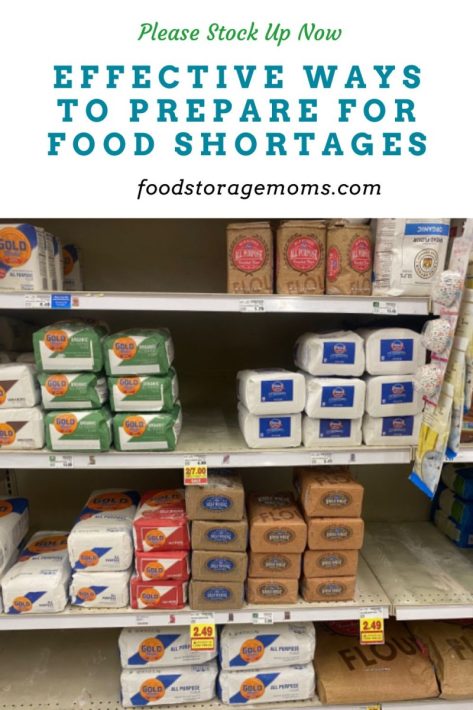
What are Food Shortages?
A food shortage occurs when there is not enough of one or more particular foods to meet the demand. Bad weather, pests, wildfires, and disease can cause this. Humans can also create food shortages through war like we see between Russia and Ukraine, or poor agricultural practices.
When a food shortage happens, the prices for the affected food group usually increase. This can make it hard for people who rely on that food to afford it. Food shortages can also lead to hunger and malnutrition, forcing people to go without certain foods or eat less and not receive the nutrients they need. These situations affect the most vulnerable, like those with limited financial means and those closest to the problem.
How to Prepare for Food Shortages
So, how can we prepare for these potential shortages? Here are a few things to keep in mind:
Identify Food Shortage Risks in Your Area
The first step is determining what food shortages could most likely occur in your area. This will help you know what foods to stock up on and how much you need. You can get this information from your local government or emergency management office. Additionally, you can check for national food shortages on the USDA website.
Plan Your Food Storage
Once you know the risks, you can start planning your food storage approach. Aim to have at least a three-month supply of non-perishable food on hand in your emergency food supply. This will help you weather any short-term shortages. You should also consider stocking up on water, as finding clean water during a crisis may be challenging.
Stock up on Non-Perishable Food Items
One way to prepare for food shortages is to stock up on non-perishable foods. This includes canned fruits and vegetables, dried beans and rice, nut butter, and shelf-stable milk. These items can last for months, or even years, without going bad if stored properly, so they’re a good option to have on hand in case of a shortage.
Here’s an essential list:
- Flour-white, all-purpose, self-rising (shelf-life 12-18 months)
- Rice
- Noodles
- Beans
- Lentils
- Oats and other whole grains
- Pasta-different shapes
- Sugar-white, light brown, dark brown
- Molasses
- Vegetable oil, olive oil
- Powdered or Instant milk
- Salt
- Baking powder
- Baking soda
- Spices and herbs
- Cans of soup
- Cans of vegetables
- Dried fruit
- Cans of fruit
- Cans of protein sources like meat and beans
- Peanut butter and Jam
- Nuts
- Tomato Sauce
- Spaghetti Sauce
- Tomato Paste
- Coconut OIl
Grow Your Own Food
Another way to be prepared for food shortages is to grow some food. This could mean planting a garden in your backyard or starting a small farm. Even if you don’t have a lot of space, you can still grow some basic crops like potatoes, carrots, and tomatoes. Take some gardening classes so you can learn what to plant and when. I have a great series of posts in my archive to help you. Learn how to start a compost pile and how to make and use mulch. If you want to get more serious about it, check out some of my gardening posts:
- Container Gardens: Everything You Need to Know
- Back to Eden Gardening Steps
- Self-Sufficient Garden: What to Grow
Join a Community Garden
If you don’t have the space or time to grow your food, you can still participate in a community garden. These are usually managed by a local organization like a church, civic club, or group of volunteers. Everyone who participates agrees to help with the garden’s upkeep and shares in the harvest.
Community gardens are great for meeting new people and getting fresh, locally-grown produce. They can also be a good option if you want to learn more about gardening before starting your garden.
If you don’t have the resources to start your own garden or participate in a community garden, be sure to support local farmers by visiting their street stands or attending farmer’s markets when available.
Store Food Properly
One way to avoid food shortages is to store food properly. This includes storing grains in airtight containers and fruits and vegetables in the fridge. By storing food correctly, you can make it last longer and reduce the chances of it going bad. Perform an inventory of your pantry to not only see what might be needed but also to clear out any expired items. Develop a consistent rotation schedule and stick to it!
Sometimes we’re tempted to buy most of our items in bulk. That can work if you have the space available. What you don’t want to do is buy in bulk to save money, and then have the food go to waste because it wasn’t used on a timely basis.
Build a Long-Term Stockpile
If you want to be prepared for a food shortage, you can build a long-term stockpile. This is a supply of food that you keep on hand in case of an emergency. A long-term stockpile should include enough food to last your family for at least six months.
Building a long-term stockpile can be a big undertaking, but it’s worth it if it means you’ll have peace of mind in case of food shortages, which are becoming more common. It’s important to be prepared, so consider starting now if you haven’t already. By following these tips, you can ensure your family has access to food during tough times that are bound to come your way.
Food Preparation and Serving Tools
Don’t forget food preparation tools such as can openers, knives, utensils, and pots and pans. If you’re stocking up on canned food, you’ll need a good-quality can opener. You may also want helpful kitchen tools like a wheat grinder, bread mixer, or a pressure canner for foods you get from your garden.
Food preservation is another option to consider. We canned a wide variety of foods as our kids were growing up. It teaches children what it takes to feed a family, how to plant and harvest, along with food preservation skills. Again, check my archive for food canning tips, you’ll be glad you did. Additionally, ensure you have gardening tools if you plan to grow your own food. Can Openers
What’s the Difference Between Short-Term and Long-Term Food Storage?
There is a big difference between short-term and long-term food storage. Let me break it down for you:
Short-Term Food Storage
Short-term storage is a 2-week to 3-month food supply. This food should be easy to rotate and use in everyday meal planning. The idea behind short-term storage is to have a reasonably small food supply in case you can’t get to the store for whatever reason.
You need to pay special attention to the needs of your infant. There recently was a shortage of baby foods, including formula. New babies can’t just be put on regular food because you ran out of their special food, they need items designed for them and their digestive tract. Plan ahead, it’s important.
Don’t forget those pets either. Pet food is something that needs to be included in your food storage plans since eating lots of human foods may not be healthy for them.
Long-Term Food Storage
Long-term food storage is a 6—to 12-month food supply that should be rotated every 6 months to keep it fresh. The idea behind long-term storage is to have a large enough supply of food on hand in case of an emergency, such as a job loss, medical condition, accident, natural disaster, or global pandemic, so that you can survive the duration of the emergency.
When stocking up for a food shortage, you’ll want to focus on long-term storage items. These are the items that will last the longest and can be used in case of an emergency. Wheat, rice, beans, oats, pasta, sugar, and salt can be stored for 20 to 30 years if packaged and stored appropriately. Additionally, freeze-dried and canned foods are great for long-term food storage.
How to Store Food Long-Term
The best way to store long-term food is in airtight containers. These containers will keep out bugs and rodents and help the food last longer. You can find airtight containers at most stores or use Mason jars.
Another option is to store food in mylar bags. Mylar bags are made of a durable material that keeps out light, oxygen, and moisture. Survivalists and Preppers often use these bags to store food for long periods.
My preference for long-term food storage is buying commercially processed freeze-dried foods. Keeping the containers cool and dry may last up to 20-25 years, depending on the temperature where they are stored. I can’t keep my house at 60 degrees, so my food storage will have a shorter life.
You’ll Need to Store Water Too
Hydration is a critical part of your daily health routine. Having clean safe water is a goal our emergency plans need to include. I have large storage tanks for storing my water, but you should also consider having a way to filter and treat your water supply. My archive is full of water storage and treatment tips. Take some time to review what information is available and then put to use what makes sense for you and your family.
You’ll need enough water to drink, cook, perform personal hygiene, and do some limited laundry tasks, even if it’s only your underwear. I suggest four gallons of water per person per day. That can add up pretty fast, so start planning and executing now!
Learn More About Food Storage
If you want to learn more about food storage, check out these posts:
- 34 Things You Need to Know About Food Storage
- Lessons I Learned From Food Storage
- What You May Not Know About Food Storage
Final Thoughts
Preparing for food shortages doesn’t have to be complicated. Following some simple tips, you can ensure that you and your family always have enough to eat and drink.
What are your thoughts on preparing for food shortages? Do you have any tips to add? Let me know in the comments below! May God bless this world. Linda



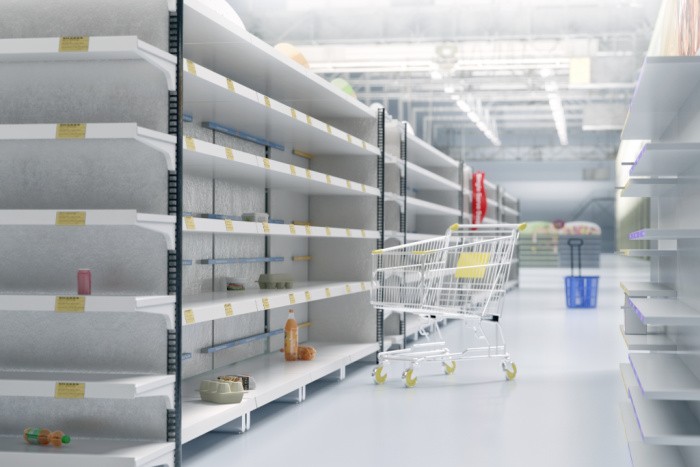
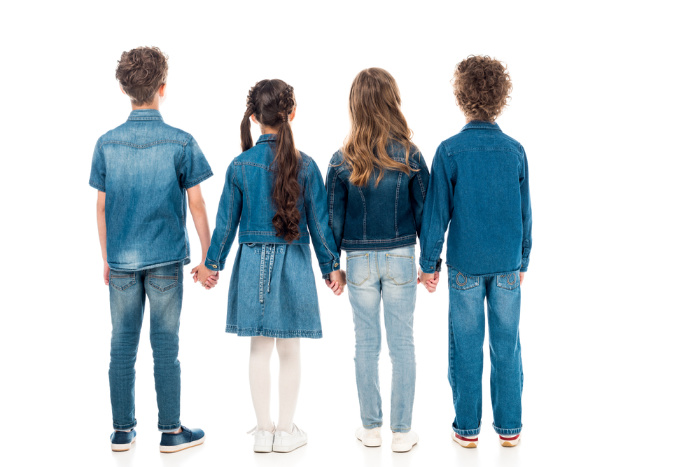



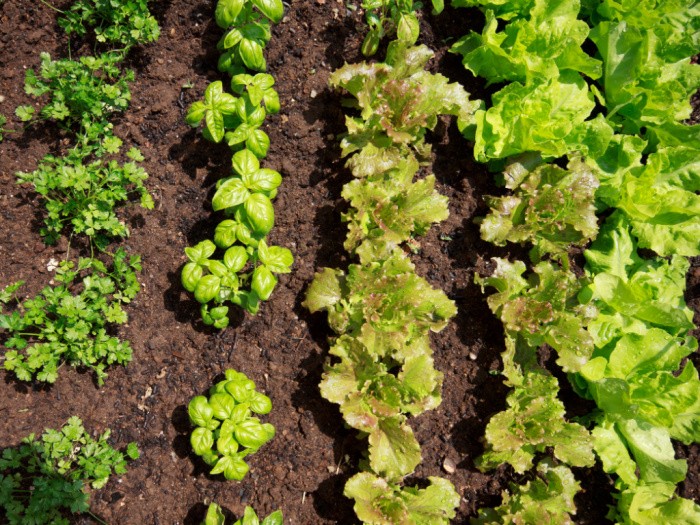











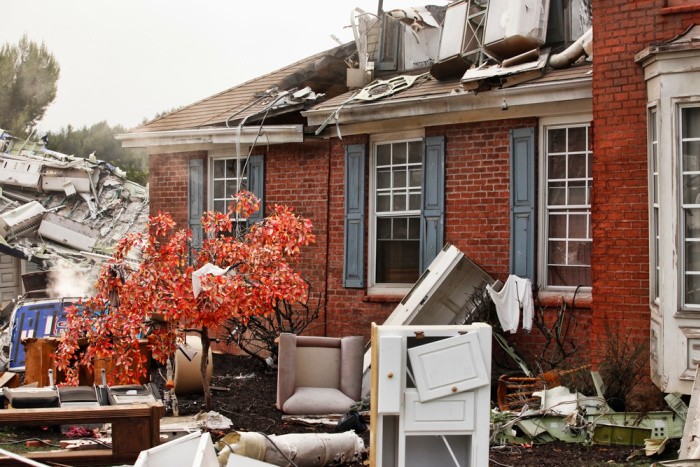


In apparition of Jesus… our food can last for Ten Years.
Whether you remove from cardboard box into clean mason jars… so bugs cannot eat boxes of food. Canned goods remove bar code so you are Not taxed by Government!
Hi Jeanne, no matter what religion people believe in we must all be prepared with food for our family. Great comment, Linda
Once again Miss Linda, you’re article and timing are right on.
Thank you,
CB
Hi Curley Bull, thank you, my friend, for your kind words. I sure hope everyone is stocking up, Linda
Hi Curley Bull, good to see you posting here,(AA) yep this is right on time..
. Everyone who reads this needs to understand if your family does not use an item and will not eat it- no need for you to spend limited funds on it.
Variety is the key and if your ability to grow for a year is impaired by illness or injury, 6 months food storage will not be enough. Each of us needs to be looking for alternate recipes to stretch the foods that are being limited in free trade.. Think grains. Most of our breads are made from wheat and cornmeal… up to 1/3 of flour grains can be replaced with non traditional grains.. like oat, potato, rice flours., even amaranth and sorrel seed..can be ground and used.. We need to be playing with these recipes now and learning how they substitute out…
if someone is not shipping it out of their country-neither should we be- except our food is being shipped to other countries daily while more mouths are being imported. Only we have someone shipping all our resources somewhere else as fast as possible.
In the time of the potato famine in Ireland.- The same thing was done- food was shipped to other nations while their own people were starving to death.
Hi Denise, I LOVE LOVE LOVE your comment! Thank you, Linda
Hello Miss Denice. It’s good to see you here too.
CB
Hi, CB! I’ve missed you at the other place. It’s good to know that you’re still busy.
Hello PG, it’s good to hear from you also. Thank you.
CB
Yes, I’m sure this article is timely for many. But, I take issue Linda with one of the items on your “basic list” & that is vegetable oils. Vegetable oils are what they call “seed oils” & are a basic NO-NO in the world of healthy eating. These seed oils are responsible for making millions of Americans sick with their use in dozens of food products manufactured by “mankind.” Some examples of seed oils are canola, soybean, vegetable, safflower, sunflower, corn, & cottonseed. They are omega-6 fats & most doctors love them, but most doctors have little knowledge of real nutrition. Better options are organic coconut or avocado oils, extra virgin olive oil (some of these aren’t so swell either), or even ghee (clarified butter). You can buy these better oils at Thrive Market, online. These are the oils I’ve put in my food storage.
Hi Janet, I totally agree with you on the oils. I store more coconut oil than any other oil. Thanks for sharing your thoughts, Linda
Great list Linda. I have been cleaning my long-term food storage, to check what I have. Like I said before, it is practically a religion. I have a pantry that looks like it is out of a magazine, (not because I care about the looks), but those little airproof containers keep things fresh. I prefer brown rice but store white rice (lasts much longer). I have been working on my recipes for white rice. Chicken fried rice is terrific.
Hi Janet, oh I love hearing your pantry looks like it’s out of a magazine! It sounds like it’s organized and easy to find stuff! Life is good when we have a beautiful pantry! I love airproof containers, I have had too many mice family reunions over the years! LOL!!! Great comment, Linda
Keep up the encouragement Linda.
To the commentary:
First priority is make sure you can eat then worry about comfort food and healthy foods. A person with a cans of spam and rice will last a lot longer than the one who didn’t buy it because it ain’t healthy or only stocked candy.
Healthy is first defined as alive then finesses down from there.
Hi Matt, thank you my friend for your kind words! I love your thought, “Healthy is first defined as alive then finesses down from there”! I have to have the basics then I add the frills like chocolate chips! I grew up on Spam and rice, it’s all good! Linda
Hi Linda:
Thank you for the information. I know about stocking things like canned veggies and other canned and jar items but there is still a lot of things I need to know. You have taught me a lot and I am still learning a lot from you.
Thank you so much
Hi Jackie, we all learn from each other. Thank you for your kind words, my sweet friend! Linda
How do I store dried beans long term so they will actually cook if I need them?
Hi Suzzan, old beans will always be a problem. You can do one of two things, pressure can them or pressure cook them in an Instant Pot. I wish I could give you some advice on how to store them but old beans are old beans and they will take longer to cook. Linda
I learned a few years ago to par-cook then dehydrate my beans. I store them in the 1/2 gallon Ball jars. They cook much faster…BUT I have never stored them more than 2 years.
Hi Hazel, I want to do that, great reminder, thank you!!! Linda
Mylar bags are great for food storage, but unfortunately they aren’t terribly puncture resistant, so I always tell folks to store them in buckets or plastic tubs to keep them from getting pierced which would allow the food to spoil. I go for overkill and put the mylar bags in food grade buckets, since I can reuse the buckets later after I’ve emptied out the mylar bags and food grade means I have more flexibility for just a little more money up front.
And even though I’m well stocked, the food processor fires are very worrying. Thanks for spreading the word. Really appreciate all you do for the prepping community!
Hi DmWalsh, the fires, the “accidents”, are something we must all think about. After a disaster, it’s too late. We must be prepared way before something happens. These fires concern me. You know what I’m saying! Linda
RE: Food storage tools.. Don’t forget spatula’s, stainless cooking spoons, extra funnels.,
also production enablers: get fertilizers while available..and things that can make fertilizer… everyone can feed earthworms and their tea is fantastic. Have a neighbor that has critters like chickens or rabbits? – 2 shovel fulls of manure in a five gallon bucket.fill with water.., leave in the sun… dilute to use and refill..is high nitrogen.. so good for plants requiring high nitrogen like greens, corn..Many plants are not productive until after 55 days.-some take 120-150 days. Be selective to plant what you will and can eat.
. Learn seed saving , so you can grow next year. then.. Foraging so you can eat fresh in earliest spring…before other crops are being harvested.
Also a warning: Watch the “pop top” cans , I lost some foods that were higher in acid and had those lids, they were not dented or dinged, they did NOT keep until their date.
For treats: consider what YOUR 2 favorite treats are to make at home.. buy all ingredients for those 2 recipes, in multiples- and put them together in a container.
Hi Denise, oh I LOVE your comment! This is why I am sharing all of my recipes. We all need food AND some treats! Linda
Linda, I can’t have so many things other people eat…i take out OR substitute all milk, then i can not digest nuts, most legumes , or whole family of Brassica’s. With these restrictions, treats become critical to break up the routine.. I can have old recipe for choc chess pie,(uses powdered coco) Choc-Oatmeal bars, and somewhere one for old fashioned tea cakes… all of these take basic ingredients.
Another idea is to make up DRINK buckets.coffee/tea//hot cocoa and hot cider packets,+ sugar, or your choice of bulk sweetener… koolaid and gatorade type powders,( these keep and are useable well beyond their dates (unsweetened and sugar sweetened.)- the artificial sweetened ones do not store well long term…
Seasoning buckets: do one for sweet seasonings and another for ones used in canning/pickle making or seasonings for meats..
Hi Denise, you are so right about having “flavored” ingredients to make a few different drinks. Luckily you know your limitations on ingredients and take care to watch for them. Linda
My husband and I are trying to figure out why the destruction at the food plants including two hit by planes are not making the nightly news. The suffering of the people in Shanghai seem unreal, but should be a heads-up for everyone. I need to upgrade the storage of my angel hair pasta from the cardboard they come in. We took a ride in the country yesterday and we found over 15 medium to larger sized fresh produce roadside stands. within 35 minutes of home. They aren’t open yet, because it is too early this far north for gardens, but now we have a map. There is no way to know how much their prices will increase, but I am reworking our budget to allocate extra, just in case. Many offer their own canned products, a God sent, since I can no longer physically do my own canning.
Hi Chris, I am very aware of the multiple fires, and accidents at food plants. It should make front-page news so to speak!! I question why we know about them but no one is talking about them. Why not? It should light a fire under some people to stock food if they aren’t already. I need to do what you did and look for Farmer’s Markets nearby. This may be the first year I cannot garden in my backyard. I will be gardening in my friend’s yard. Linda
For years, I have had my pasta in 5 gallon buckets….nothing added. I remove from the box, wrap a rubber band around the pasta and stack upright.
I have emptied a few and still have a few full buckets. I eat a lot of meals using spaghetti pasta.
I have never had a meal with bad pasta. I store macaroni the same way…remove from the box and dump.
All my pastas are in buckets, some small 2 gallon buckets in a closet.For years, I have had my pasta in 5 gallon buckets….nothing added. I remove from the box, wrap a rubber band around the pasta and stack upright.
I have emptied a few and still have a few full buckets. I eat a lot of meals using spaghetti pasta.
I have never had a meal with bad pasta. I store macaroni the same way…remove from the box and dump.
All my pastas are in buckets, some small 2 gallon buckets in a closet.
HI JayJay, I love hearing how you store your pasta, I love any kind of pasta and I store it in airtight containers and buckets as well. I sould eat spaghetti every single week, in fact we do! LOL! Love your comment, Linda
Thank you Jayjay for your input. I am going to do exactly what you suggested, although I think I will start with 2 gallon buckets, because shelf size is an issue.
Hi Chirs, 2 gallon buckets are a great size! Linda
For the past 12 years, I have bought all my beef and chicken locally, and I receive half of the eggs and milk I need from a family member if they have any extra. In hopes it will be helpful to someone, I’d like to share the resources I use to find locally grown food with you because I know not everyone has farmers in their family. I will preface this by saying that I save at least 30% by buying a whole or half cow, however, I pay 50% more when I buy pasture-raised – organic chickens locally. Taking that into consideration, I’m certainly fine with it.
TIP: As painful as it may be to say, farms come and go. Check each resource on a regular basis. Also, keep in mind that a farm will not be “posted” all across the “board” so to speak, so cast a wide net.
For Produce:
pickyourown.org/
– You can save more by picking your own, plus it’s a great activity to do with your family, friends, spouses, dates, youth
groups, and Scouts.
– There is a lot of useful information on this site.
ams.usda.gov/local-food-directories/farmersmarkets
– USDA’s directory of registered farmers’ markets.
nfmd.org/
– National Farmers Market Directory
localfarmmarkets.org/USfarmmarkets.php
– Directory of farmer’s markets, roadside stands, or farm stands.
For Meat, Milk, & Eggs:
localmeatmilkeggs.org/US.php#
eatwild.com/products/
georgiacattlemen.org/i4a/pages/index.cfm?pageID=3320
– This is for my home state, which I posted so that you can check to see if your states’ cattlemen chapter has a similar
resource.
I personally find it reassuring in knowing where my food comes from, i.e. the U.S., and find it very rewarding in getting to know the hardworking good folks in my community who plays a trivial part in making sure that my table has a hearty meal to nourish my body and soul. I find that it helps keep me grounded and humbled as it is needed from time to time.
Hi Ravenna, oh my gosh, thank you for sharing ideas on how to get good meat, fruit, and vegetables! Times are crazy right now, we need every option we can find. Linda
It’s my pleasure! The fact that other countries do not have the same standards regarding food handling as we do makes it important to know where our food comes from. As a result of my firsthand experience, I know that some other countries we import from exploit child labor to keep costs down. Knowing that I try to support local American farmers as much as possible. Check out this link beef2live.com/story-united-states-beef-imports-204-107547 for more information on how much beef the US imports and from which countries.
Tucker Carlson did a segment on the food shortages and the destroyed food processing plants that the main stream media has chosen to hide from America . Unfortunately, he didn’t really have an answer as to why these incidents are being hidden. Thoughts???
Hi Chris, yes, I love watching Tucker Carlson, will we ever really know the truth? I doubt it. Just my 2 cents. Linda
I would like to know the story behind so many plant fires. No one is reporting on this. Which then speculation
comes roaring in. Another American problem in which we aren’t being told the truth
Hi Pamela, I did a little research and I’m not as concerned as I was before looking into it. Here’s the post I wrote about them. https://www.foodstoragemoms.com/food-processing-plants-burned/
My name is Charlene Aaron. I’m a reporter with CBN News/The 700 Club.
I’m working on a story about how people can prepare for food shortages. While doing research I came across your website and I’d love to interview you about this subject.
Please let me know if you’re available sometime next week for a Zoom interview.
Thanks,
Charlene Aaron
CBN News
Hi Charlene, sure, let me know what works for you, Linda
Let’s plan for Tuesday. Can you please mail me directly please so I can send you details?
Linda and Charlene…… please send us any link to this article when it is available. Thank you
Hi Chris, I felt in my best interest I needed to pass on it. Linda
Great repost, Linda!
I am still of the mind that we need to store what we eat and eat what we store!! Of course, along with that, I think we do need to store long term foods (25+ years freeze dried) to some extent. So the person(s) who worry about old beans not cooking properly – purchase beans but eat them and replenish them. My daughter buys dried beans and cans them so they are shelf stable. Rather than just storing dried beans that may or may not take forever to cook!! Those wanting to store brown rice long term, cook the brown rice to your desired tenderness, rinse well and dehydrate! Or if you have access to a freeze drier, freeze dry for longer term storage – I would think probably up to 5 years. Flour can be vacuum sealed if done properly and extend the shelf life a bit.
Again, though, I believe in store what I eat and eat what I store! It is all about rotation for me.
Hi Leanne, oh you nailed it on buy what you eat and store what you eat! No waste, and learn to cook from scratch. Canning beans a great way to soften them. Just follow the USDA guidelines and you will be fine. Linda
This article is even more important as time goes on. Thanks again Linda!
Hi Paula, I totally agree, my sweet friend! Linda
Linda, as usual you have hit the nail on the head. Can’t think of a single thing to add except to say Coconut oil lasts a long time–much longer than other oils (at least that’s my experience).
Planted the last of my 13 varieties of tomatoes today along with another cuke. Nasturtiums and Marigolds are going in tomorrow along with Bush Porto Rico sweet potatoes. I’m harvesting asparagus, lettuce (3 varieties), carrots, peas, chard and bok choi. Soon I’ll have cabbage, broccoli, and two other varieties of peas. In one of my beds the peas appear to have a virus so as soon as I get them harvested I’ll pull them and put in corn, beans, squash (3 Sisters) and melons.
Hope you are feeling much better.
Hi Ray, thank you for your kind words. I will go add coconut oil, I feel the same way about oils, they go rancid quickly. Oh, your garden makes me so happy, I can almost visualize it. The NoroVirus was short-lived but the it appears I have been needing oxygen for sometime. I have scarring in my lungs. I have never smoked or vaped a day in my life. Now i’m on oxygen 24/7. Now, I’m this 74 year old lady going to doctors appointments non-stop. Yes, with my feet kicking! LOL! The builder is finally doing the finish work, the kitchen cabinets are being built. It’s been a slowwwww process! LOL! Linda
Linda, calling your home construction a slowwwww process is being generous. I just turned 74 myself so I get it.
I am very glad to hear you are doing better. You know, even if you won’t be able to get a garden in this year, you can always grow sprouts–quick, easy and nutritious.
Hi Ray, LOL! Generous is a very good word. It’s been an interesting situation. I used to keep track of how many holidays would pass during the build. There were so many, I quit counting! LOL! Hopefully by July 4th! You will hear fire crackers going off if it happens through an email from me to you! LOL! Linda